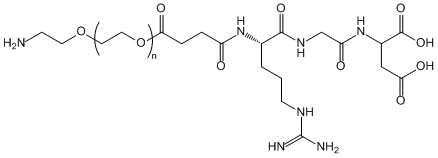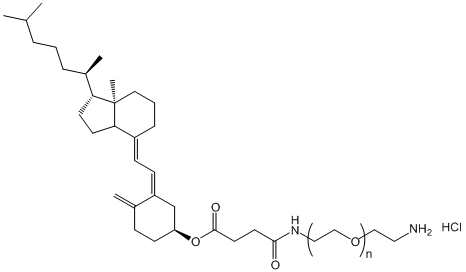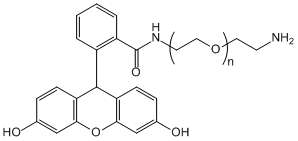-
Monodispersed PEGs
- >Methoxy PEG (mPEG)
- >Azide(N3) PEG
- >Amine(NH2) PEG
- >Hydroxyl(OH) PEG
- >Thiol(SH) PEG
- >Boc/Fmoc PEG
- >Carboxylic Acid(COOH) PEG
- >Maleimide(Mal) PEG
- >NHS ester PEG
- >Biotin PEG
- >Aldehyde (Ald/CHO)PEG
- >Acrylate(AC) PEG
- >Acrylamide(ACA) PEG
- >DBCO PEG
- >DSPE PEG
- >Other Lipid PEG
- >Fluorescent (FITC) PEG
- >Rhodamine B(RB) PEG
- >Cholesterol PEG
- >OPSS PEG
- >Epoxide (EPO) PEG
- >Hydrazide (HZ) PEG
- >Folic Acid(FA) PEG
- >Lipoic acid(LA) PEG
- >Methacrylate (MA) PEG
- >Silane PEG
- >PEG Sulfonic acid
- >PEG PFP ester
- >PEG TFP ester
- >Halide (F,Cl,Br,I) PEG
- >Benzyl-PEG
- >Aminooxy PEG
- >Hydrocarbons PEG
- >Nitrophenyl Carbonate (NPC) PEG
- >DNP PEG
- >Other PEG
- >PROTAC Linker
- >View More
-
Polydispersed PEGs
- >Methoxy PEG (mPEG)
- >Azide(N3) PEG
- >Amine(NH2) PEG
- >Hydroxyl(OH) PEG
- >Thiol(SH) PEG
- >DSPE PEG
- >Carboxylic Acid(COOH) PEG
- >Maleimide(Mal) PEG
- >NHS ester PEG
- >Other Lipid PEG
- >Acrylate(AC) PEG
- >Boc/Fmoc PEG
- >Biotin PEG
- >Aldehyde (Ald/CHO)PEG
- >Fluorescent (FITC) PEG
- >Cyanine (Cy) PEG
- >Rhodamine B(RB) PEG
- >Cholesterol PEG
- >OPSS PEG
- >Acrylamide(ACA) PEG
- >Epoxide (EPO) PEG
- >Hydrazide (HZ) PEG
- >Folic Acid(FA) PEG
- >Lipoic acid(LA) PEG
- >Methacrylate (MA) PEG
- >Silane PEG
- >PLGA PEG
- >PCL PEG
- >PLA PEG
- >PEG Sulfonic acid
- >PEG PFP ester
- >Halide (F,Cl,Br,I) PEG
- >Aminooxy PEG
- >DBCO PEG
- >Hydrocarbons PEG
- >Nitrophenyl Carbonate (NPC) PEG
- >Other PEG
- >View More
-
Multi-arm PEGs
- >Hydroxyl(OH) PEG
- >NHS ester PEG
- >Amine(NH2) PEG
- >Maleimide(Mal) PEG
- >Azide(N3) PEG
- >Thiol(SH) PEG
- >DBCO PEG
- >Carboxylic Acid(COOH) PEG
- >Aldehyde (Ald/CHO)PEG
- >Methoxy PEG (mPEG)
- >Acrylate(AC) PEG
- >Biotin PEG
- >Cholesterol PEG
- >OPSS PEG
- >Acrylamide(ACA) PEG
- >Epoxide (EPO) PEG
- >Hydrazide (HZ) PEG
- >Folic Acid(FA) PEG
- >Lipoic acid(LA) PEG
- >Methacrylate (MA) PEG
- >Silane PEG
- >Halide (F,Cl,Br,I) PEG
- >Hydrocarbons PEG
- >Nitrophenyl Carbonate (NPC) PEG
- >Other PEG
- >View More
- PEGs by Application
- Lipids for Lipid Nanoparticles
- PEG Raw Material
CatalogID: 11368 Purity: ≥95%
-
Synonyms:
Amino-PEG-RGD
Amine-PEG-ARG-GLY-ASP
-
Purity:
≥95% -
Recommended Storage Condition:
Store at -5°C,keep in dry and avoid sunlight. -
Uses:
Applicated in medical research, drug-release, nanotechnology and new materials research, cell culture. In the study of ligand, polypeptide synthesis support, a graft polymer compounds, new materials, and polyethylene glycol-modified functional coatings and other aspects of the active compound.
NH2-PEG-RGD is a PEG linker terminated with an amine group (NH2) and RGD peptide motif. RGD (arginine-glycine-aspartic acid) is a well-known cell adhesion motif found in extracellular matrix proteins like fibronectin and vitronectin. It interacts with cell surface integrin receptors, particularly αvβ3 and α5β1 integrins, to mediate cell adhesion, migration, and signaling processes.
NH2-PEG-RGD is commonly used in biomaterials and tissue engineering applications to functionalize surfaces or nanoparticles, allowing for enhanced cell attachment and targeting of specific cell types. By conjugating the RGD motif to the PEG spacer, NH2-PEG-RGD provides a flexible and biocompatible platform for the design of biomaterials with improved cell interactions and tissue integration properties. It finds applications in areas such as regenerative medicine, drug delivery, and targeted cancer therapy, offering researchers a powerful tool to modulate cell-material interactions for various biomedical applications.
Biopharma PEG offers a wide range of PEG products from lab to commercial scale in both non-GMP and GMP grades. Email at sales@biochempeg.com and start using a superior product for your next product R&D project.

Cat.No:HE008005
Cat.No:HE090050
Cat.No:HE022050
Cat.No:FL005290
Cat.No:NE12458
Cat.No:FL296005
Cat.No:MF001170






-peg-nh2.gif)


